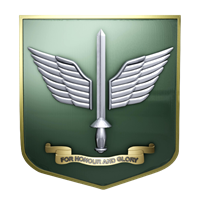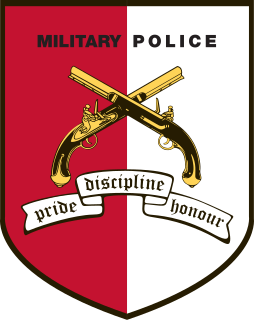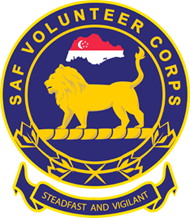
The green beret was the official headdress of the British Commandos of the Second World War. It is still worn by members of the Royal Marines after passing the Commando Course, and personnel from other units of the Royal Navy, Army and RAF who serve within 3 Commando Brigade and who have passed the All Arms Commando Course.

The Singapore Armed Forces (SAF) are the military services of the Republic of Singapore, responsible for its defence and national interests. A military component of the Ministry of Defence (MINDEF), it is one of the most capable, robust technologically sophisticated and powerful militaries in Southeast Asia and the surrounding regions.

The Singapore Army is the land service branch of the Singapore Armed Forces (SAF). It is the largest of the three services and primarily a conscript army that in the event of national exigencies or war, morphs itself from peacetime to a war footing by mobilising almost all of its combined combat power by calling up operationally-ready military reservists.

The SAF Commando Formation is the special operations formation of the Singapore Armed Forces (SAF) responsible for conducting special operations. It is only made up of one battalion, the 1st Commando Battalion.

The Singapore Armed Forces Military Police Command (SAFMPC), also known as the SAF MP Command, previously known as the Singapore Armed Forces Provost Unit (SAFPU), is the military police formation of the Singapore Armed Forces (SAF).

The Singapore Infantry Regiment (SIR) is the main and largest formation of the Singapore Army. It consists of seven battalions made up of regular servicemen and a number of battalions made up of conscripts and reservists.

The 10th Parachute Brigade, commonly known as 10 Para, is an elite brigade-sized airborne unit within the Malaysian Army tasked with being rapidly deployed inside or outside the boundaries of Malaysia. 10 Para is the key element of the Rapid Deployment Force.
Singapore has had an history of armed conflict and personnel dating to the colonial period.

The maroon beret in a military configuration has been an international symbol of airborne forces since the Second World War. It was first officially introduced by the British Army in 1942, at the direction of Major-General Frederick "Boy" Browning, commander of the British 1st Airborne Division. It was first worn by the Parachute Regiment in action in North Africa during November 1942.

The tan beret also known as a beige beret has been adopted as official headgear by several special operations forces as a symbol of their unique capabilities.
The red beret is a military beret worn by many military, paramilitary, commando, and police forces and should not be confused with the maroon beret worn by airborne troops all around the world.

Troops began wearing berets as a part of the headgear of military uniforms in some European countries during the 19th century; since the mid-20th century, they have become a component of the uniforms of many armed forces throughout the world. Military berets are usually pushed to the right to free the shoulder that bears the rifle on most soldiers, but the armies of some countries, mostly within Europe, South America, and Asia, have influenced the push to the left.

In the United States Army, tabs are cloth and/or metal arches displaying a word or words signifying a special skill that are worn on U.S. Army uniforms. On the Army Combat Uniform and Army Service Uniform, the tabs are worn above a unit's Shoulder Sleeve Insignia (SSI) and are used to identify a unit's or a soldier's special skill(s) or are worn as part of a unit's SSI as part of its unique heritage. Individual tabs are also worn as small metal arches above or below medals or ribbons on dress uniforms.

The Singapore Armoured Regiment (SAR) is a formation of the Singapore Army responsible for armoured warfare. Armour provides mobile firepower support and rapid mobility for the Army by helping to spearhead an advance past the enemies defences and seizing and holding key objectives on the battlefield. Armour also acts as an active deterrent towards any possible aggressors. Armour is known to act swiftly as they can be deployed at a moment's notice to dominate the battlefield, hence their motto: Swift and Decisive.

The Khmer National Army was the Land Component of the Khmer National Armed Forces (FANK), the official military of the Khmer Republic during the Cambodian Civil War between 1970 and 1975.

The Singapore Armed Forces Volunteer Corps (SAFVC) is a uniformed volunteer auxiliary branch of the Singapore Armed Forces. It was established on 13 October 2014 to allow Singaporean women, first generation permanent residents and naturalised citizens, all of whom would otherwise not be subject to an obligation to serve national service, to contribute their part towards Singapore's defence. It also aims to strengthen support for national service by understanding the duties of national servicemen.
Dieppe Barracks is a military installation used by the Singapore Army. It is located at the northern tip of Singapore, on Sembawang Road adjacent to Khatib Camp and Sembawang Air Base.
The SAF Day Parade is an annual military parade and ceremony of the Singapore Armed Forces held on 1 July in commemoration of the founding of the SAF. It is the second military parade in seniority to be held in Singapore next to the Singapore National Day Parade in August. It is usually held at the SAFTI Military Institute in Jurong West while in the presence of the President of Singapore in their position as commander-in-chief. Salutes are also taken by the Prime Minister of Singapore, and the Chief of Defence Force.
David Neo Chin Wee is a Singaporean major-general who has been serving as Chief of Army since 2022. He previously served as Deputy Secretary (Technology) at the Ministry of Defence.

















